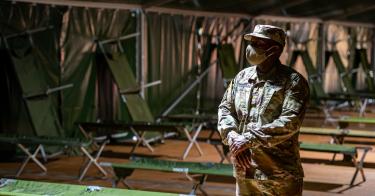In the early days of the COVID-19 pandemic, the Trump administration was criticized for not using the Defense Production Act quickly enough or in sufficient quantity to counter the spread of coronavirus. Now, after using the act 33 times since March 18, there is no denying that the administration is utilizing the act to fight this public health crisis.
But as the coronavirus pandemic hits the defense industrial base, the act’s initial purpose—to secure the production of goods critical to national defense—must not be forgotten. Fortunately, this has not been overlooked by the Trump administration.
The Defense Production Act of 1950, as amended, is a federal statute, passed during the Korean War that confers upon the president a broad set of authorities to influence domestic industry in the interest of national defense. “National defense” can include emergency and disaster response.
>>> What’s the best way for America to reopen and return to business? The National Coronavirus Recovery Commission, a project of The Heritage Foundation, assembled America’s top thinkers to figure that out. So far, it has made more than 260 recommendations. Learn more here.
Through this act, the executive branch has struck agreements with multiple companies to accelerate COVID-19 countermeasures, like N95 protective masks, testing swabs, and vaccine development.
Invoking the act has been vitally important in acquiring medical supplies to fight the COVID-19 pandemic. It was critical in boosting domestic ventilator production to meet the country’s rapidly-growing demand for ventilators earlier in the pandemic.
Defense Production Act authorities and funds are also paving the way for the manufacture and distribution of a future COVID-19 vaccine, should one pass clinical trials.
In recent months, the act has been used for more than just medical supplies. The Department of Defense has used funds that Congress has provided under the act to reinforce the U.S. defense industry across multiple sectors, including aviation, shipbuilding, microelectronics, and space, among others.
This is appropriate and overdue.
Interventions permitted by the act include issuing loans and grants to strategically significant companies, prioritizing government contracts, controlling the allocation and distribution of certain goods, and even compelling producers to make certain products. All of the actions taken by the Defense Department with Defense Production Act funding fall within these categories.
Even before the onset of the coronavirus pandemic, the defense industrial base faced a number of vulnerabilities. In 2017, President Donald Trump issued Executive Order 13806, which required the Secretary of Defense to lead an assessment of the health of the industrial base. The resulting report found a host of problems, like aggressive industrial behavior of competitor nations, single- and sole-source suppliers of key components, and diminishing trade skills.
Many companies crucial to the nation’s defense are small businesses with narrow profit margins who struggle to survive. Even large companies face sizeable obstacles, like unpredictable government funding and threats to the defense budget.
Adding a global pandemic to the mix creates serious danger for the defense industry, and by extension, national security.
The defense industry was partially shielded from the impact of COVID-19 by its designation as part of the country’s “critical infrastructure.” This helped exempt defense companies from state shutdown orders, but not from a slew of other coronavirus-induced problems.
Some companies were forced to shut down because too many workers became infected: approximately 1,000 defense firms had to shut down due to coronavirus, and while now only 35 are still closed, many are behind schedule.
Many companies are also falling behind because of supply chain issues, as one small part made by one small company overseas can hold up an entire program.
Recent Defense Production Act actions pertaining to the defense industrial base have aimed to mitigate these problems and keep defense firms in business.
One example is a $25 million agreement made with Weber Metals, a California-based company which makes large, open and closed die forgings used in Defense Department weapons systems. The $25 million agreement will allow Weber Metals to retain its workforce and rehire workers laid off due to the pandemic.
While responding to COVID-19 should be the first priority, policymakers cannot afford to neglect the need to maintain a strong and healthy defense industrial base.
Recent Defense Production Act spending choices appear to be well-balanced between the country’s immediate need for medical supplies and its long-term need for a strong national defense and robust defense industrial base—an industrial base that is being hit hard by the coronavirus pandemic.
This piece originally appeared in The Daily Signal




